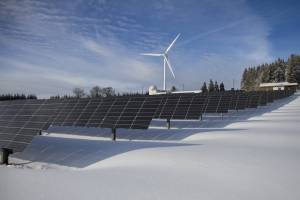Top Green Energy Sources

- Solar Energy: Solar energy is one of the most widely recognized and rapidly growing sources of green energy. It harnesses the power of sunlight through photovoltaic (PV) panels or solar thermal systems to generate electricity or heat. Solar energy is abundant, renewable, and emits no greenhouse gases during operation, making it a clean and sustainable energy source.
- Wind Energy: Wind energy utilizes wind turbines to convert the kinetic energy of the wind into electricity. As the wind turns the turbine blades, they spin a generator that produces electrical power. Wind energy is renewable, widely available, and emits no greenhouse gases during operation. It has the potential to supply a significant portion of the world’s electricity needs.
- Hydropower: Hydropower, also known as hydroelectric power, generates electricity by harnessing the energy of moving water. It uses the gravitational force of falling or flowing water to turn turbines, which then drive generators. Hydropower is a renewable energy source, emits minimal greenhouse gases, and provides a reliable and continuous power supply.
- Geothermal Energy: Geothermal energy utilizes the heat from the Earth’s core to generate electricity or provide heating and cooling. It involves extracting heat from underground reservoirs of hot water or steam and converting it into usable energy. Geothermal energy is renewable, reliable, and emits very low levels of greenhouse gases, making it an environmentally friendly energy source.
- Biomass Energy: Biomass energy utilizes organic matter, such as wood, agricultural residues, and dedicated energy crops, to generate heat or electricity. It can be converted into biofuels or burned directly to produce energy. Biomass energy is considered renewable, as new organic material can be grown to replace what is used. However, the sustainability of biomass energy depends on responsible sourcing and ensuring minimal environmental impact.
- Tidal Energy: Tidal energy captures the kinetic energy of tidal movements to generate electricity. It involves using turbines placed in tidal areas or estuaries, where the rise and fall of tides generate a predictable and consistent energy source. Tidal energy is renewable, highly predictable, and emits no greenhouse gases during operation.
- Wave Energy: Wave energy converts the energy of ocean waves into electricity. It utilizes devices, such as oscillating water columns or floating buoys, to capture the wave motion and convert it into mechanical energy, which is then transformed into electricity. Wave energy is a renewable source with significant potential, although it is still in the early stages of development.
- Hydrogen Energy: Hydrogen energy is considered a green energy source when produced through renewable methods, such as electrolysis using electricity from renewable sources. Hydrogen can be used as a clean fuel for various applications, including transportation, heating, and power generation. When produced using renewable energy, hydrogen has the potential to play a crucial role in decarbonizing various sectors.
Each of these green energy sources has its unique advantages and considerations, and their suitability may vary depending on geographical, economic, and technological factors. A combination of these sources, along with energy efficiency measures and responsible energy consumption, is crucial for transitioning to a sustainable and low-carbon energy future.
The Green Energy Revolution: Exploring the Top Renewable Sources